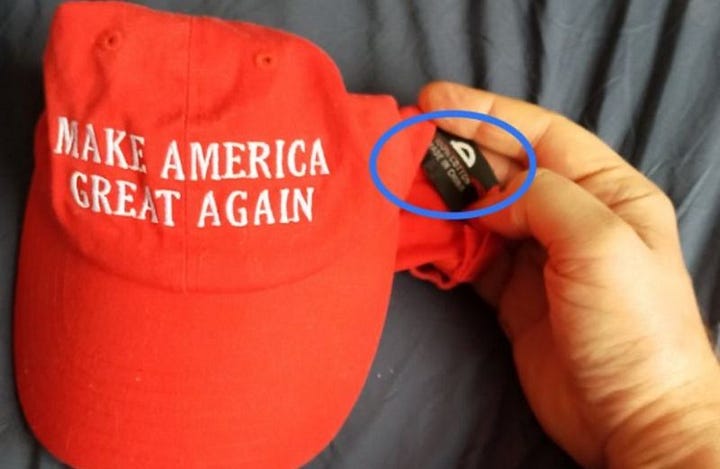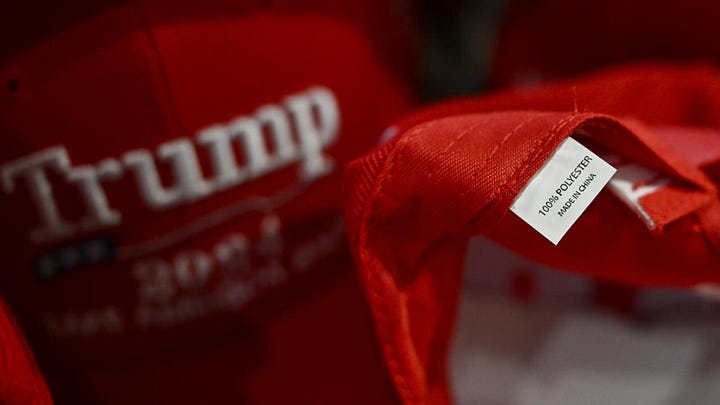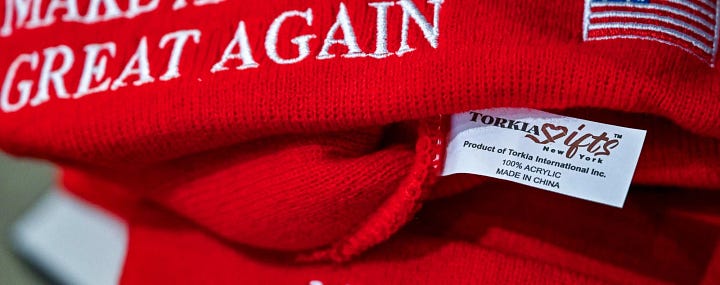Which Part Was Made in America?
The label says America, the parts say China, and Lutkin can't explain supply chains.
Howard Lutkin at 9:24am on 5/11/25.
Since it’s Mother’s Day today, you may have missed the reinforcement of Lutkin’s inability to understand two concepts: Interdependence and Supply Chain.
Before we dig in: Happy Mother’s Day!
Here’s Lutkin
Whatever just came out of Lutnick’s mouth is bullshit. A grotesque version of patriotic performance art for the willfully deceived. For MAGA, just as long as you slap “Made in the USA” on a product, it suddenly becomes sacred, untouchable, blessed by the Founding Fathers, and the ghost of “trickle down” Reagan.
“Made in America”. It's a ritual phrase, repeated like a prayer by politicians with rolled-up sleeves on the campaign trail (GOP is too scared to appear at town halls), and corporate execs looking for subsidies. However, as soon as you turn over Trump’s “Make America Great Again” hat, you’ll find what you already knew: “NOT Made in America.” It’s a lie. But it’s the best kind of lie. It’s an American lie. The kind we’re addicted to. It’s the only thing really Made in America.




If we’re defining “Made in the USA” with anything resembling honesty in manufacturing, meaning every component, every raw material, every hand and machine involved in the process was located on U.S. soil, then we’re talking about less than 5% of consumer goods. Realistically, less than 2% are made in the USA from scratch to sales.
The Supply Chain: A Map of Our Dependencies
The American supply chain isn’t American. It’s global by design. So are most other nations’ supply chains. We’re not the abused exception here.
A T-shirt printed in Ohio? The cotton may have originated in India. The dye probably came from Germany. The cargo ship that brought it over, may have been sailing under a Korean flag. Even the “support our troops” bumper sticker is printed on vinyl made in China with oil products pumped from Saudi fields.
Irrespective of whether the final print was applied in the USA, the materials did come from outside our borders. Therefore, yes, these materials are subject to tariffs upon import, and before the printer had an opportunity to apply the ink.
This isn’t a conspiracy theory, it’s simple logistics, supply chain, global markets, and interdependencies between nations. For us, it's the result of four decades of American policy that prioritized efficiency over resilience, stockholder gains over adequate compensation of the American worker, and union busting, which may be the other thing truly “Made in America”.
The modern consumer economy is an ever-spinning wheel of global interdependence, where even the most “American” products are Frankenstein’d from a mix of foreign parts.
The Myth of Industrial Integrity
Sure, some industries maintain higher U.S. source materials content. But even there, the interconnectedness of nations and materials is undeniable.
Defense and Aerospace: Yes, most components are sourced domestically, because the law mandates it. But look closer. Even military gear relies on foreign, rare-earth elements. National security may be American, but the minerals are mostly from abroad.
Food and Agriculture: A cow raised in Kansas is American beef. But the feed might be Brazilian. The fertilizer? Russian. The John Deere, International, or whatever else tractor brand that’s rolling on a farm? Built with parts from several countries. And when the farmer needs repairs? The same foreign parts that were used in the assembly will fix the tractor. Sure, US labor, but with foreign parts.
Artisanal Goods: That’s about the only hedge, and even that’s sketchy. The blacksmiths, tanneries, and knife-makers or wood shop artists. Incredible work, made in America with American materials, whenever possible. But these are unicorns. Micro-economies. Their output isn’t scalable enough to shift GDP, and their success is often algorithm-dependent, found more often on Etsy or YouTube than in your local Walmart aisle.
Their cost is justifiably higher. It’s the labor power of one artisan, perhaps locally sourced materials, but likely foreign parts-assembled tools. The forge, bandsaw, leather tools, etc., are likely made abroad. Yet still, they’re trying.
However, showcasing what their efforts mean in relation to compensation will get you to recognize that the MSRP of their goods is mostly outside the general consumers’ financial buying power. And even if you splurge on a $250 handmade leather wallet, you don’t do that often, and your one-time purchase does not offset the 300 factory-assembled objects we purchased from Amazon last month.
The artisan’s product is amazing, but we can’t buy at scale to change the economy that way. Because if we did, the artisan would need to manufacture at scale. Enter the circular catch-22. When they go the manufacturing route, the internationally interdependent supply chain will render them no longer artisan and no longer purely “Made in America.”
The FTC’s Convenient Loophole
Legally, a product can be labeled “Made in USA” if “all or virtually all” components are domestic.
“Virtually all” is the key phrase. Unfortunately, it’s as vague as it is exploitable. A screwdriver assembled in Michigan with a Chinese handle and a Taiwanese shaft? Still might qualify. Your microwave? Final assembly in Ohio, but every chip, sensor, board, and button probably came from Shenzhen.
Ultimately, while it should be about truth, it’s mostly about perception. And we, the consumers, are complicit in that delusion because it feels good to buy “Made in America”. It feels righteous. It feels like we’re voting with our dollars, even while we’re hemorrhaging quality of life.
Globalization wasn’t an accident. It was a plan to address opportunities for greater profitability and shareholder returns. “Trickle-down economy” meant that from the 1980s on, we shipped factories overseas, reduced the number of skilled workers, and chased cheap labor like the shareholders’ lifestyle dependent upon it. Perhaps it does, because fueling that yacht isn’t cheap.
The result? We extracted labor, outsourced, offloaded production, denied the impacts, and now we’re left with an insufficient model of manufacturing that we can’t scale up quickly enough to undo the self-inflicted harm.
Emphasizing our dependencies, the pandemic showed us how fragile the American system really is. One hiccup in the South China Sea, shelves go bare, and toilet paper is sold for a premium on the black market.
What’s Left That’s Truly American?
Let’s say you want to buy a 100% American-made product. Here’s what you’ll need:
A spreadsheet.
An industrial supply chain map.
A degree in trade policy.
And a fat bank account.
For context, I’m a bit of a sarcastic punk here. None of these items will get you to buy 100% American. Because the deeper you dig into sourcing, the more you’ll find global footprints.
Per MSN, even Kirkland (Costco) toilet paper is processed from pulp harvested in Canada. It’s good toilet paper, but it’s not American toilet paper. Unless you count Alberta as the 51st state.
The Real Cost of the American Label
We pay the price in more ways than one.
Emotionally, the label is a placebo. It soothes our patriotic nerves, while it drains our wallets more than when we acknowledged that TEMU has about the same quality as Amazon. Because the same object came, most likely, from the same factory.
Economically, tariffs are the taxes you pay. Not China. Not Mexico. Not Canada. You. American importers pass those costs on. They have absolutely no choice if they want to stay in business. Unfortunately, while we’re getting robbed at checkout, Trump & Lutkin sell you the illusion that “we’re finally winning” and “no longer taken advantage of!”
Strategically, we are at the mercy of our trade partners. We can’t build solar panels, cell phones, or semiconductors without considering the international supply chain. That’s not the acclaimed sovereignty we seek. It’s also not independence or American exceptionalism. It can’t be, because we sold out to strategic dependency to satisfy the greedy.
The Way Out
If you want 100% Made in America, here’s your checklist:
Accept higher prices.
Accept fewer choices.
Demand transparency.
Be patient.
Realistically, though, total self-reliance is dead. At least under the current model.
We could rebuild and reshore. We could also invest in domestic infrastructure. But that takes political will instead of sabotage. It also takes economic empowerment, adequate worker compensation, the sacrifice of shareholder returns, and consumer patience. We are lacking in all metrics.
Until we reach complete cohesion, when someone tells you that it was “Made in the USA,” we should probably ask, “Which part?”
###
~Z.






I'm 100% American made! Though, not a global commodity. Ah well. 🙂